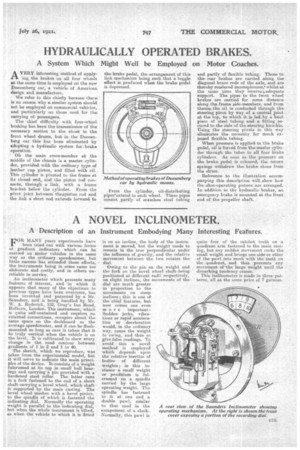A NOVEL INCLINOMETER
Page 13

If you've noticed an error in this article please click here to report it so we can fix it.
A Description of an Instrument Embodying Many Interesting Features.
FOR MANY years experiments have been tried out. with various forms of gradient indicators which can be carried on motor vehicles in the same way as the ordinary speedometer, but little success has attended these efforts, • the instruments being in some cases too elaborate and costly, and in others unreliable in service.
An inclinometer which presents many features of interest, and in which it appears that many of the objections to previous types have been overcome, has been invented and patented by a Mr. Saunders, and is being handled by Mr. W. 4. Roderick, 152, Gray's Inn Road, Holborn, London. The instrument, which is quite self-contained and requires no external connections, occupies about the same space on the dashboard as the average speedometer, and it can be flushmounted so long as care is taken that it he truly vertical when the vehicle is on the level. It is calibrated to show every change in the road contour between gradients of 1 in 2 and 1 in 90.
The sketch, which we reproduce, was taken from the experimental model, but it will serve to indicate the main principles of the device. It consists of a weight fulcrumed at its top in small ball bearings and carrying.is pin provided with a hardened steel roller. The latter runs in a fork fastened to the end of a short shaft carrying a bevel wheel, which shaft is supported by the main casting. The bevel wheel meshes with a bevel pinion, to the spindle of which is fastened the indicating dial. Normally the operating Weight is parallel to the indicating dial, but when the whole instrument is tilted, • as when the vehicle to which it is fitted
is on an incline, the body of the instrument is moved, but the weight tends to remain in the true perpendicular under the influence of gravity, and the relative movement between the two rotates the dial.
Owing to the pin on the weight and the fork on the bevel wheel shaft being positioned at different radii respectively, on slight inclines, the movements of the dial are much greater in proportion to the movements on steep inclines ; this is one ofthe chief features, but now comes One even mo r e important : Sudden jerks, vibrations or rapid acceleration or deceleration would, in the ordinary way, cause the weight to swing, and thus to give false readings. To avoid this a novel method is employed which depends upon the relative inertias of bodies of different weights; in this instance a small weight or pendulum is fulernmed on a spindle carried by the large operating weight. The spindle has fastened to it at one end a double pawl, similar to that used in the escapement of a clock. Normally, this pawl is quite free of the ratchet teeth on a quadrant arm fastened to the main casting, but any sudden movement rocks the small weight and brings one side or other of the pawl into mesh with the teeth on the quadrant, and thus prevents any movement of the large weight until the disturbing tendency ceases.
This inclinometer is made in three patterns, all at the same price of 7 guineas.
































